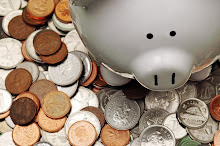In today’s tough economy many consumers are now shopping with a grocery list to help save money. They realize a list helps them focus on their shopping purchases, helping them avoid the ever present, but costly, impulse purchases.
Yet supermarkets realize that shoppers are increasingly entering their stores with a singular purpose in mind - to grab the items on their list and get out quickly. In effect, consumers have developed “tunnel vision” - traveling up and down supermarket aisles looking only for those groceries that are on their mental or physical shopping lists.
In response, grocery stores have placed “speed bumps” in their aisles - items that physically or psychologically interrupt a consumer’s tunnel vision and steer them toward impulse purchases. These “speed bumps” have become so prevalent that grocery store aisles frequently resemble obstacle courses making navigation with a large shopping cart difficult.
Let’s take a look at a few of these “speed bumps.”
Over-Sized Signs. How does a product attract the attention of a shopper who’s flying by to their intended purchase? - With a sign located right on the store shelf of course!
The bigger the better. The problem - in order to break our “tunnel vision” these signs have grown larger and larger. If you’re not careful it can be quite easy to actually side swap some of the larger grocery store shelf signs.
And if you thought that was bad enough, how about these mega-sized ceiling signs that seem to drop in front of your face from nowhere?
Floor Advertisements. What’s the best way to grab your attention? Place an advertisements where you’d least expect it. The supermarket floor has become the perfect spot and floor ads are popping up in supermarkets faster than weeds in a backyard garden.
Just be careful though. While you’re distracted looking at the floor you could get side-swapped or rear-ended by another shopper. (It nearly happened to me!)
As with the shelf signs, floor ads are meant to distract us from our true shopping targets and steer us toward impulse purchases.
Stand Alone Product Displays. Stand alone displays are perhaps the most annoying attempts to break shopper “tunnel vision” and get customers to notice products they might have otherwise sped right past. Its hard not to notice a display that juts right into your shopping path. Navigating large shopping carts with two or more people in the aisle becomes a little more challenging.
But perhaps more annoying, however, is how these displays lure you into thinking an item is on sale. Frequently the stand alone product display will have a large printed sign attached to it. Naturally, many assume this means the product is on sale when in fact it isn’t.
Warehouse Displays. The next “speed bump” is what I term the warehouse display in which a grocery store stacks items still in their shipping boxes on the store floor. This is similar to how many items are displays in a warehouse store like Sam’s. Like the stand alone display these are hard to miss - which I surmise is the intended purpose.
I secretly wonder if the store is trying to achieve what I call a “Costco effect”, trying to get you to equate the low warehouse store prices with the featured product. As with stand alone displays you have to be extra careful when you see a large printed price sign on the item and not naturally assume its on sale.
More and more shoppers understand how costly impulse buys can become. As a result, they frequently shop with a mental or physical shopping list.
Knowing this, grocery stores look to disrupt our tunnel vision for just a moment with “speed bumps.” They intend to grab our attention for just a second. In this split second they tempt us to make that impulse purchase - to deviate from our mental or physical shopping list.
The best advice - stick to your guns and your shopping list. Ignore the large shelf signs and navigate right around those stand alone product displays. Your wallet will love you for it.
 Lesson: Store coupon dispensers can be a valuable source for coupons - just don't fall into the trap of thinking that you have to use them right away. Instead, save them for the next sale and redeem the coupons for a bigger savings at the register.
Lesson: Store coupon dispensers can be a valuable source for coupons - just don't fall into the trap of thinking that you have to use them right away. Instead, save them for the next sale and redeem the coupons for a bigger savings at the register.







